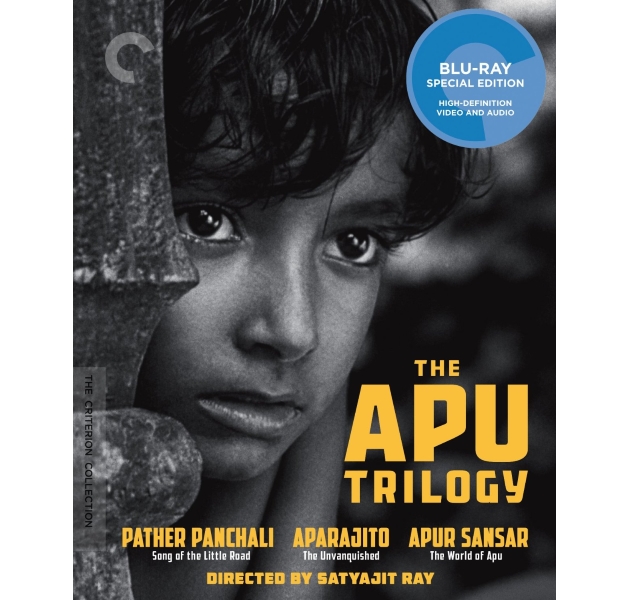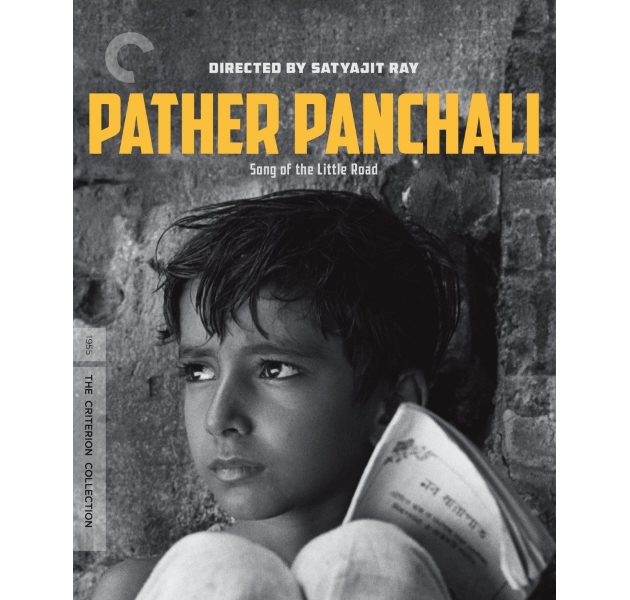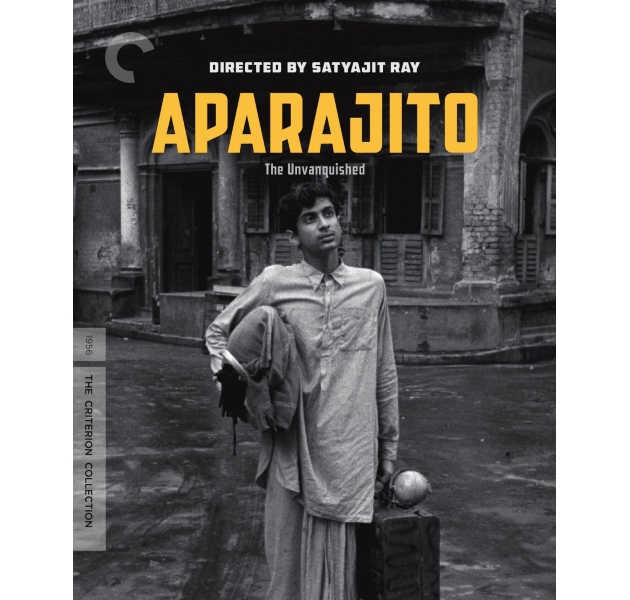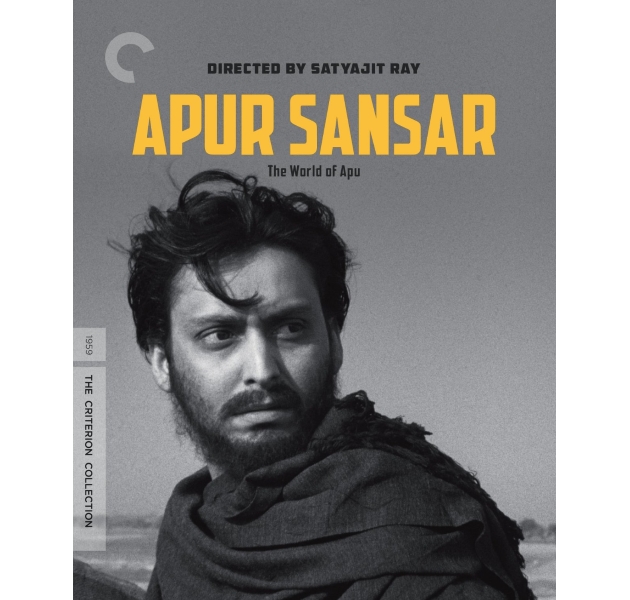Blu-ray Review: Finally, THE APU TRILOGY Receives The Attention It Deserves
I've always felt that admitting that I'd never seen them would immediately strip me of any credibility as a critic or aficionado of Indian cinema. When I first became aware of The Apu Trilogy, it was relatively early in my hardcore film fanaticism. The context in which I found them was through the fast and furious world of out-of-print DVD buyers and sellers. The original US discs were already out of print when I started collecting, so it became a totem for me, though one that I was never able to grasp.
It wasn't until I began my love affair with Indian cinema a few years later that the films came back into my life, but now they were virtually unattainable. Rumors began to spread that a restoration was underway from the available elements, most of which were badly damaged in a fire. I figured this would be my shot to finally wash the shame from my face and see these films properly. It was, I am glad, and the world is a better place.




It's too much to attempt to approach these films as one whole, so I've split up this review into three parts, one for each film/disc. You can find each of them by clicking through the gallery.
What these reviews don't mention is the exceptional 44 page booklet that is included in the set. This one is long, even by Criterion's standards, and features excellent essays from Terrence Rafferty and Girish Sambu, but most engaging to me were a collection of Ray's original storyboards for Pather Panchali. Ray's background was as a visual artist who actually came into contact with Pather Panchali when he designed and illustrated the cover and innards of the book when it came out. His connection to the material is clear and beautiful. Don't forget to check it out!
Now, onto the films...
Satyajit Ray's Apu Trilogy is one of the most studied, well-regarded, and most beloved films series in the world. In fact, at this point I really don't think that I could possibly offer up a fresh view or insight that hasn't already been stated in words ten times more eloquent than my own. However, I do feel an obligation to talk about the films somewhat.
Pather Panchali (Song of the Little Road) was Satyajit Ray's first film. While the series is commonly known as The Apu Trilogy, and the little boy Apu is a central character in Pather Panchali, it is really a story about the life being lived around Apu, and that is its beauty. We are introduced to a struggling Bengali family consisting of the mischievous older daughter Durga, the impossibly aged auntie Indir, the traveling patriarch priest Harihar, and the woman who holds it all together, the harried mother-wife Sarbajaya, and halfway through the film, Apu, a miracle baby who grows up before our eyes.
This family, all spreading out in different directions apart from the anchor of Sarbajaya, is a typical one, it is only their surroundings and the specificity of their routines that distinguishes them from any other. They are poor, and they are desperate, but they are also grateful, kind, loving, and headstrong. While the trilogy may bear his name, Apu is merely significant in this film for being adjacent to greatness. Whether it is following around his older sister as she has adventures and tries to grow up as quickly as possible, or getting in her way at every turn, Apu doesn't look like a child who has greatness in him, but that's what makes him so endearing. Not precocious, not particularly unique, just a boy, doing what boys do.
One aspect of Pather Panchali that is significant in terms of it's relation to the rest of contemporary Bengali film, is that it celebrates the ordinary. Even in the '50s, Indian mainstream and regional cinema was dominated by escapist musicals, but Ray didn't want to make a film like that. Pather Panchali is significant not only because it's not a musical, but because it depicts rural life as it was, and in some places still is.
It would be impossible to gauge the time period of Pather Panchali solely based on the visuals of the first hour or so of the film. It could have been contemporary or it could have been a period film, the state of the village gives us no indication either way. It isn't until the intrusion of a railroad track and some power lines cut the screen in half that we're given that bit of context for the film. Villages like this still exist in rural areas of India, perhaps with better plumbing and some updated cell phones and such, but those places are still out there, and they make appearances in modern films, both art-house and mainstream, regularly.
What I took from Pather Panchali was more of a gathering of emotions than a thesis. The film deliberately sidesteps traditional narrative in favor of a collection of significant moments and uses them to draw a picture of this family's life. For every happy moment, there are two sad ones, and this is a theme that Ray continues through the trilogy. As long as the last one is happy, and in this case it is at least hopeful, that's all that matters. All of the memories are like rocks on the little road.
The Disc:
I'm only going to write about the quality of the transfer and restoration once, because it is fairly consistent across the board. It is stunning. I'll go into more detail when I talk about the restoration video extra on Apur Sansar, but it looks incredible. The vast bulk of the film looks sensational with rich black and white cinematography that has beautiful deep shadows and an almost impossible amount of detail. The only place where it is obvious that the film was significantly damaged is in some of the transitions, which are virtually impossible to restore. If nothing else, they provide something of a yardstick to show how much work was done, and how well. The final three of four minutes of the film also look a bit rougher, but it's hardly a concern after having see the amazing work on the rest. The uncompressed mono soundtrack is also gorgeous. No hiss, clear dialogue, and Ravi Shankar's score comes through beautifully.
Extras:
-
Audio recording of Satyajit Ray reading his essay “A Long Time on the Little Road” - This is just what the title says. This was actually my first encounter with the mellifluous voice of Satyajit Ray, and let me say, I could listen to the man speak for hours. Here he reads an essay about making Pather Panchali during an interview. Lots of interesting anecdotes, however, his voice is so soothing that I'd listen to him read a phone book if I was able
-
Interviews with Soumitra Chatterjee, Shampa Srivatava, and Soumendu Roy – Chatterjee played Apu in Apur Sansar, but his interview here is interesting in that it talks a lot about the way Ray directed his actors, which was, in essence, whatever worked best for the actor. Srivastava played the young Durga in the film and while she doesn't have a lot of juicy info on the making, she does have very fond memories. Soumendu Roy was a camera assistant on the film, and he shares a few stories about the technical side of the film, he also went on to be the director of photography in some of Ray's later films.
-
Excerpts from a 2003 documentary The Song of the Little Road – This featurette compiles footage from an earlier doc in regard to the work of composer Ravi Shankar. Shankar talks about how he scored the film, why he used certain instruments for certain scenes, and the fact that the entire film score was recorded in a single all-day session.
The second film in The Apu Trilogy is Aparajito (The Unvanquished). While Ray never intended to make a series from Pather Panchali, the film was so successful both critically and financially that his producers insisted, and he most definitely make the best of it. This film picks up right where Pather Panchali leaves off, Apu and his family leaving their village to begin a new life in Benaras.
Apu's father, Harihar, is a priest who decides to take the family to the holy city of Benares (now known as Varanasi) where he can make a living performing religious rites along the banks of the Ganges river. While Harihar is working, Apu and his mother attempt to eke out a living. Young Apu, no more than seven years old at the beginning of the film, treats the streets and back alleys of Benares as his playground, he learns more from playing with his friends in a few months than he ever learned back in the village. When he sees children his age in school, he becomes determined to go and study for himself. Along the way he faces financial hardship, emotional struggle, and yet more loss, leading him to become increasingly independent for better or for worse.
Aparajito may not have been planned from the beginning, but Ray certainly imbues it with a sense of continuity with the first film. The trilogy has a great sense of flow, with each event happening as part of the continuum that builds not only a complete picture of the story but also the character, both literary and emotional, of Apu. The English translation of the title, The Unvanquished, refers to the spirit of Apu, the boy turned man who is able to turn his tragedy into not necessarily opportunity, but perhaps at least the drive to succeed and move away from the life that has taken so much from him.
This is a film about hope that comes from surviving loss. Apu's life until this point is all about loss, the loss of his sister and his Auntie from the first film, as well as the losses that continue piling up as he gets older. With every loss comes a new perspective and one more thing that he must do for himself without the help of the people who are now gone. Apu continues to see possibility and opportunity and a future for himself, in spite of a world that seems desperate to break him down.
Ray's vision for Aparajito is clearly about transitions. Not only the major transition of Apu from a boy to a young man, but also the transition of India from a rural nation to a more urban one. This is a transition that is just as poignant today as it was sixty years ago. Apu's family's move from the country to the city is a move that many Indians continue to make in an effort to find opportunities that just don't exist outside of them. When the film was made, India as a nation was only a decade old, and still attempting to find its own identity was proving very complex. While their independence was brand new, this was a nation with thousands of years of art and literary culture. However, a century of the British Raj had sublimated the native culture for what was seen, even by many Indians, as the superior Western culture. It's a battle that India is still fighting today, but in 1956 the wounds were still very fresh and Aparajito manages to comment on those challenges through everyday interactions and expectations without being preachy.
A worthy follow-up to a nearly impossible to follow debut feature for Satyajit Ray.
Extras:
-
The Small Details – A fascinating interview with Ujjal Chakraborty regarding the cultural specificities of The Apu Trilogy. One of the challenges of viewing films that originate from anotehr culture is that it is inevitable that something of the film will be missed by those who do not live within that culture. Chakraborty bridged the gap nicely with this short interview in which he lets us in on the secrets.
-
Audio recording of a conversation between Ray and historian Andrew Robinson – More details about the making of the films. I just love listening to Ray speak.
-
Making “The Apu Trilogy”: Satyajit Ray's Epic Debut – A visual essay from Andrew Robinson. This one is fascinating. It discusses Ray's filmmaking and the growth that he makes between and even during projects. One of the highlights of the extras for sure.
-
The Creative Person : “Satyajit Ray” - This is an exceptional TV documentary from 1967 which follows Ray around Calcutta and Bengal while he is the the process of filming and researching for a new film. The talk from Ray and his collaborators is absolutely fascinating. Ray moves from visual and literary influences to technical mechanics, to the importance of locations during this 30 minute documentary. He talks a lot about Charulata, which he'd recently completed, and The Adventures of Goopy and Bagha, which he was in the middle of planning.
The final film in the Apu Trilogy is Apur Sansar (The World of Apu). In this film, Satyajit Ray wraps up his trilogy in an unusually satisfying way, despite the possibilities it presents for the future. Ray again picks up where the previous film leaves off, with Apu in Calcutta at college, or so his mother thinks. Warning, this is quite spoilery as it's tough to describe the film and its themes without getting into plot details.
Apur Sansar begins with Apu attempting to make a living as a writer, having come up short in school fees. As many of my colleagues are more than aware, living as a writer is no easy task, and those who can make a comfortable living at it are few and far between. Such is Apu's destiny, while hunting for writing gigs, he also looks for jobs to help may his rent, on which he is already three months behind at the beginning of the film.
While he is in the thick of his self-indulgent moaning, he is visited by an old college friend who invites him to a family wedding as a guest as a way to cheer him up. Apu reluctantly agrees, and his life changes forever. While at the wedding, Apu becomes a surprise groom when the arranged husband turns out to be “mad”, and the family scrambles desperately for a man to fill the position as the bride's auspicious window closes rapidly. Apu agrees for the sake of the girl, Aparna, and the two begin a tenuous relationship of convenience.
When they arrive back home at Apu's room, it quickly becomes clear that he can no more support a wife than he can support himself. He has a tutoring job, but it pays barely enough to feed him, and he spends most of his days trawling the Calcutta streets looking for anything to help him get by. He eventually finds a position as a clerk that does the trick, and the pair grow beyond their mutual shyness to find love in their home.
Aparna is more than simply Apu's wife, she is his savior in that she shows him a life beyond his own. At this point in the story, Apu has lost so much that he shuns human interaction and the bondage of relationships. He's not without reason, nearly every significant relationship he's even had has ended in loss, but through patience, compassion, and admiration, Aparna breaks that streak, and the two begin a wonderfully understated romance that results in Aparna's pregnancy.
When Aparna returns to her family home for the final trimester of her pregnancy, Apu is left alone in his home. He misses her dearly, and works hard to save money for the time when his family will be reunited. Sadly, he experiences further loss when Aparna dies in childbirth. This is his final straw, when Aparna dies, the last bit of hope in Apu dies and he becomes a wandering vagrant. He stops shaving and caring about his appearance and begins to wander the Indian countryside in search of anything to keep him moving. When his old friend finds him, he insists that Apu visit the child he's never met, Apu resists at first, but eventually relents. The story from here on out is fairly predictable, but does a nice job of closing the circle in terms of Apu's life as one man and the beginning of his life as a father.
Apur Sansar is touching, heart-wrenching, and traumatic, like all of the trilogy, but it is probably also the most focused of the films, with a definitely plot structure and narrative rather than the slice of life vignettes Ray focused on in the first two films. With this, his fourth film, Satyajit Ray finds his feet, and realizes that a film need not rewrite the rule book to be exceptional, sometimes it's more than enough to simply do what others do, but do it better.
Extras:
-
Interviews with Soumitra Chatterjee and Sharmila Tagore – More interview footage with Chatterjee specifically about his role in this film some of the many other films he made with Ray. Soumitra became the biggest star in Bengali cinema during the decades that followed Apur Sansar. Sharmila Tagore played Aparna. She was very young at the time, and she shares some of her memories from the making of the film. In the decades following this film she became one of the greatest actresses and beauties in Bollywood.
-
“The Apu Trilogy”: A Closer Look – A new program from filmmaker Mamoun Hassan. At 43 minutes, this is the longest video featurette in the entire package. Hassan takes a long look at not only the films, but also the books that inspired it. Bibhutibhushan Bandyopadhyay’s books served as that inspiration, but with hundreds of characters, they would've been impossible to adapt traditionally. Hassan looks at the way Ray adapted the books to focus on characters, rather than the overview of village life from the original books. A fascinating watch that brings further depth to the trilogy
-
Footage of Ray receiving an Honorary Oscar in 1992 – This is only three minutes, and it it is kind of sad to watch because Ray was quite ill (he died 2 months later), but it is wonderful to hear him talk about his love of films and great to see him get recognition for his work, even if it was almost too late.
-
Restoration documentary – This is amazing. This short program, only thirteen minutes, goes into the efforts required to recreate The Apu Trilogy from badly damaged elements. The story goes that the negatives were in storage in London and a fire in the facility badly damaged the vast majority of the original materials. The film was restored and repaired in Italy and then further restored back at Criterion. The condition of the original elements is heartbreaking, but when you see the comparison shots it is truly breath-taking. This cannot have been an easy or inexpensive fix. Film lovers will be absolutely fascinated. These guys deserve a medal.

Around the Internet
Recent Posts
Leading Voices in Global Cinema
- Peter Martin, Dallas, Texas
- Managing Editor
- Andrew Mack, Toronto, Canada
- Editor, News
- Ard Vijn, Rotterdam, The Netherlands
- Editor, Europe
- Benjamin Umstead, Los Angeles, California
- Editor, U.S.
- J Hurtado, Dallas, Texas
- Editor, U.S.
- James Marsh, Hong Kong, China
- Editor, Asia
- Michele "Izzy" Galgana, New England
- Editor, U.S.
- Ryland Aldrich, Los Angeles, California
- Editor, Festivals
- Shelagh Rowan-Legg
- Editor, Canada









